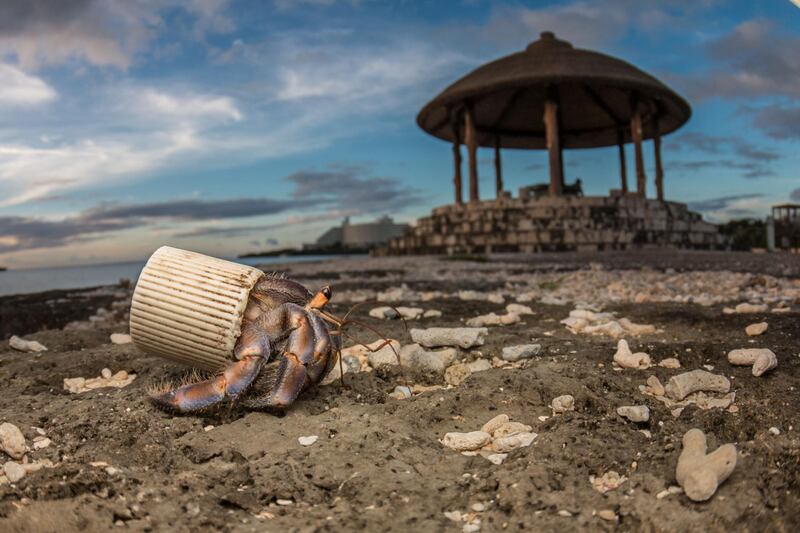There is no "away" when we try and dispose of items made from plastic, and the more we let that sink in, the more we can do to change the fate of this planet.
It's disturbing to consider that the toothbrushes I used when I was a toddler in the early 1970s still exist somewhere. My grandparents' Bakelite telephone; the casing of my family's first television set; the bird-proof stoppers my grandmother used to protect her milk bottles on the doorstep; the ruler from my first geometry set; the shopping bag that danced around in the wind during the most poignant scenes in the film American Beauty – all of these things are somewhere else today, in one form or another. And they will be for many hundreds of years.
Who is (and isn't) tackling the problem
Ignorance is not an excuse and, like many of society's most serious ills, the corporations making huge profits on the back of producing single-use plastics have little or no inclination to change the status quo. Last year, United States President Donald Trump overturned a six-year-old policy that allowed America's national parks to ban the sale of plastic water bottles – a move that benefited no one except the multinational companies making them.
With the G7 Ocean Plastics Charter, the United Kingdom, Canada, France, Germany and Italy have all agreed to ramp up plastic recycling by 50 per cent, along with other positive steps to reduce the impact of plastic on the environment. Two countries refused to sign: Japan and the US, with Trump not even bothering to attend that part of the recent G7 summit. Both the US and Japan have huge plastics industries that employ millions of people and generate enormous revenues, but anyone with an open mind can see the problems these companies have created.
The UK and the European Union have announced plans to ban plastic straws, plastic cotton buds and single-use plastics like cutlery and bags. India, too, has pledged to ban single-use plastics by 2022, and China – the world's leading generator of plastic pollution – is taking steps to tackle the problem through a ban on the import of plastic waste.
When you realise that 17 million barrels of oil are used each year to make plastic water bottles (and a million cars could be fuelled instead), the enormity of the problem becomes crystal clear. With so much money, so many jobs and so many shareholder dividends at stake, the industries benefiting from our reliance on plastic are unlikely to get a conscience and change their ways.
The planet is, ironically, exacting its own form of revenge. A study published earlier this year by the UK’s University of Hull and Brunel University in London, provided evidence of the potential harm that we humans are doing to ourselves.
'The more we look, the more we find plastic'
In a mass dissection of supermarket-supplied mussels, 70 particles of microplastic were discovered in every 100 grams of flesh. We’ve poisoned the sea and now it’s coming back for us. This month, the UK government banned the supply of products that include microbeads, which are really small plastic particles used in face and body scrubs, shower gels, toothpastes, cleaning chemicals and even chewing gum. It’s a bigger step than we might give it credit for, with a UK government committee having found that 100,000 microbeads can make their way to the sea after a single shower. And these tiny pieces of plastic act as magnets for other, properly nasty pollutants, before being consumed by fish and entering the food chain.
All of these seemingly insignificant policy and law changes will together have a cumulative effect and, as the saying goes, doing anything is better than doing nothing. And, for a final wake-up call, we could do worse than look to Greenpeace's Protect the Antarctic campaign, in which over three months, from January to March this year, samples of ice, snow and water were collected and analysed. Most contained microplastics.
__________________
Read more:
The final straw: here are the alternatives to plastic
The unsettling facts about plastic pollution
Profligate plastic waste needs action now
__________________
“Plastic has now been found in all corners of our oceans, from the Antarctic to the Arctic and at the deepest point of the ocean, the Mariana Trench,” says Greenpeace’s Frida Bengtsson. “We need action at source, to stop these pollutants ending up in the Antarctic in the first place, and we need an Antarctic Ocean sanctuary to give space for penguins, whales and the entire ecosystem to recover from the pressures they’re facing.”
Novelist and artist Douglas Coupland was so dismayed by the pollution washing up on his favourite part of Canada's coast that he collected tonnes of it for use in an exhibition at the Vancouver Aquarium.
“The more we look,” says Coupland, “the more we find plastic in our food and in our water. It’s now becoming harder to distinguish where our bodies end and where the synthetic world begins. I got to thinking of growing up in the 1960s, back when people still littered. Young people have trouble believing this but people just tossed stuff out the car window or onto the streets with no thought about it, and then, almost overnight in the early 1970s people stopped littering.”
He's right, of course, and some of us are old enough to remember the shift in human behaviour. We have to believe that we're capable of doing something similar again.






